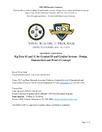An analysis of fuel efficiency as a key performance parameter for military aircraft acquisitions
| dc.contributor.advisor | Whitaker, Lyn R. | |
| dc.contributor.author | Young, Laurence Martin | |
| dc.date.accessioned | 2012-03-14T17:45:29Z | |
| dc.date.available | 2012-03-14T17:45:29Z | |
| dc.date.issued | 2002-09 | |
| dc.identifier.uri | https://hdl.handle.net/10945/5464 | |
| dc.description.abstract | The Acquisition Management System (AMS) of the Department of Defense (DoD) is established to ensure that the needs of the warfighter are fulfilled in the most cost-effective manner possible. The establishment of Key Performance Parameters (KPPs) on Operational Requirements Documents (ORDs) ensures that critical measures of performance are continuously monitored as the identification of a military requirement becomes a fulfilled capability. Threshold values for KPPs identified during an acquisition determine the minimum acceptable level of performance. Failure to meet the threshold level of an individual KPP is grounds for program cancellation. The Chairman of the Joint Chiefs of Staff (CJCS) has mandated that all defense acquisition programs should be kept to a maximum of eight for any individual program. Due to the multifaceted aspect of modern military aircraft acquisition programs, frequently there are numerous parameters of critical importance. For this reason, any repetition of measure between KPPs must be minimized. The decision of the Principal Deputy Undersecretary of Defense for Acquisition, Technology and Logistics (PUSD (AT&L)) to include fuel efficiency as a KPP on all future acquisitions is an unnecessary exercise for military aircraft. This thesis develops a model in which multiple aircraft are examined flying different mission profiles carrying different weapon payloads. Strong relationships between factors such as combat radius, payload and on-station endurance versus fuel efficiency are demonstrated by regression analysis of the model output. Consequently, any measure of fuel efficiency as a KPP is shown to be redundant. Furthermore, the methodology developed in this thesis may have further uses for the development of logistics planning factors for present and future military aircraft applications. | en_US |
| dc.description.uri | http://archive.org/details/annalysisoffuele109455464 | |
| dc.format.extent | xviii, 110 p. : ill. ; | en_US |
| dc.publisher | Monterey, California. Naval Postgraduate School | en_US |
| dc.rights | This publication is a work of the U.S. Government as defined in Title 17, United States Code, Section 101. Copyright protection is not available for this work in the United States. | en_US |
| dc.subject.lcsh | Government purchasing | en_US |
| dc.subject.lcsh | United States | en_US |
| dc.subject.lcsh | Logistics | en_US |
| dc.title | An analysis of fuel efficiency as a key performance parameter for military aircraft acquisitions | en_US |
| dc.type | Thesis | en_US |
| dc.contributor.secondreader | Sanchez, Paul J. | |
| dc.contributor.department | Operations Research (OR) | |
| dc.subject.author | Fuel Efficiency | en_US |
| dc.subject.author | Key Performance Parameters | en_US |
| dc.description.service | Lieutenant, United States Navy | en_US |
| etd.thesisdegree.name | M.S. in Operations Research | en_US |
| etd.thesisdegree.level | Masters | en_US |
| etd.thesisdegree.discipline | Operations Research | en_US |
| etd.thesisdegree.grantor | Naval Postgraduate School | en_US |
| etd.verified | no | en_US |
| dc.description.distributionstatement | Approved for public release; distribution is unlimited. |
Files in this item
This item appears in the following Collection(s)
-
1. Thesis and Dissertation Collection, all items
Publicly releasable NPS Theses, Dissertations, MBA Professional Reports, Joint Applied Projects, Systems Engineering Project Reports and other NPS degree-earning written works.





